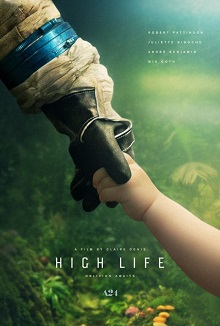High Life is a Twistedly Enchanting Vision

April 25, 2019
5/5
(not to be confused with the 2009 comedy movie High Life)
[Spoiler alert]
High Life is a science-fiction masterpiece. It feels like a film coming from an established director, with a lot of science fiction experience, which makes it even more surprising to realize that the film was helmed by Claire Denis; this is her first science fiction film.
It’d be easy to mistake High Life for Interstellar or The Martian. High Life has a visually impressive black hole, which looks very similar to the black hole from Interstellar. And there’s a garden in space, which might seem reminiscent of the greenhouse that the protagonist of The Martian makes. But High Life takes very little time to stray from its visual predecessors. Because it tells a much different story; a much darker story. The crew aboard the spaceship, known to the audience simply as “7,” are all criminals on death row. They were sent to space as disposable humans who could conduct dangerous suicide missions out in space, such as investigating a black hole. While that could lead to a very interesting philosophical debate in and of itself (and, in fact, Denis briefly seems to lead it in that direction, showing a discussion between an ethical scientist and a reporter, but she never goes through with it), the film chooses to focus on the effect that living in a confined space can have on a group of people, who aren’t necessarily the most sane or the most restrained. What results is a sophisticated glance into human behavior and alienation.
High Life is not for the faint of heart. It is difficult to sit through, constantly building and climaxing into a gory and disturbing scene. I’ve never considered the amount of disturbing content in a film to be a point of criticism, because it is often in service of the plot, and the same holds true here. High Life justifies its scenes of sexual violence and spaghettification (yes, that’s the technical term, meaning the vertical stretching and horizontal compression of objects in a strong gravitational field), with a narrative that probes and questions as much as it horrifies. But, boy, does it horrify.
My only criticism for High Life is the scene between an ethical scientist and a reporter that brings into question the morality of sending prisoners on death row into space for a suicide mission. But, the scene doesn’t go anywhere. While the film does condemn the idea by extension of the plot, the scene is an unnecessarily forceful exposition and not as well written as the rest of the movie. In spite of this, High Life is a masterful film by a seasoned director and it demands to be seen by a wider audience. It’s easily the best film of 2019 (so far).






